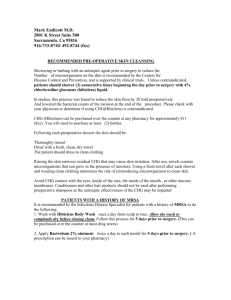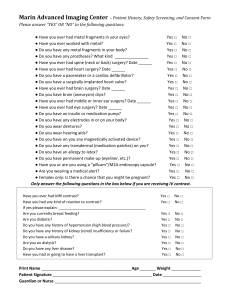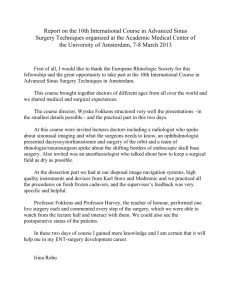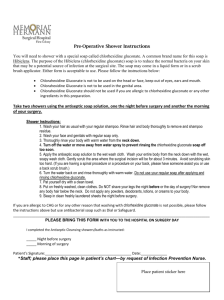Legacy Good Samaritan Medical Center
advertisement
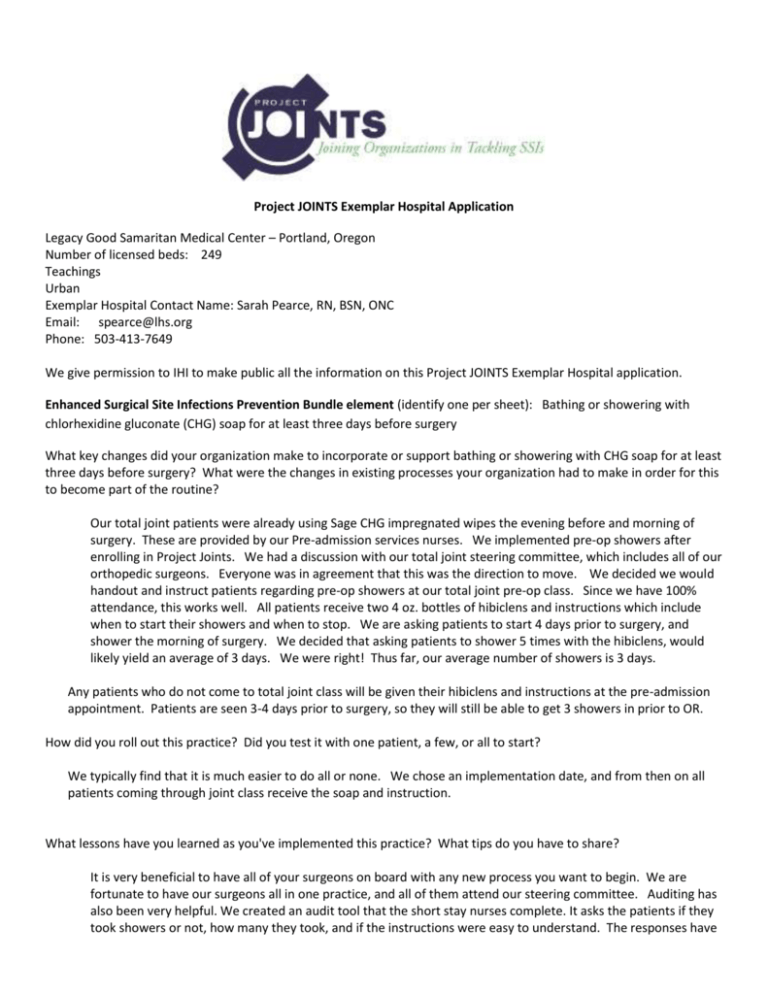
Project JOINTS Exemplar Hospital Application Legacy Good Samaritan Medical Center – Portland, Oregon Number of licensed beds: 249 Teachings Urban Exemplar Hospital Contact Name: Sarah Pearce, RN, BSN, ONC Email: spearce@lhs.org Phone: 503-413-7649 We give permission to IHI to make public all the information on this Project JOINTS Exemplar Hospital application. Enhanced Surgical Site Infections Prevention Bundle element (identify one per sheet): Bathing or showering with chlorhexidine gluconate (CHG) soap for at least three days before surgery What key changes did your organization make to incorporate or support bathing or showering with CHG soap for at least three days before surgery? What were the changes in existing processes your organization had to make in order for this to become part of the routine? Our total joint patients were already using Sage CHG impregnated wipes the evening before and morning of surgery. These are provided by our Pre-admission services nurses. We implemented pre-op showers after enrolling in Project Joints. We had a discussion with our total joint steering committee, which includes all of our orthopedic surgeons. Everyone was in agreement that this was the direction to move. We decided we would handout and instruct patients regarding pre-op showers at our total joint pre-op class. Since we have 100% attendance, this works well. All patients receive two 4 oz. bottles of hibiclens and instructions which include when to start their showers and when to stop. We are asking patients to start 4 days prior to surgery, and shower the morning of surgery. We decided that asking patients to shower 5 times with the hibiclens, would likely yield an average of 3 days. We were right! Thus far, our average number of showers is 3 days. Any patients who do not come to total joint class will be given their hibiclens and instructions at the pre-admission appointment. Patients are seen 3-4 days prior to surgery, so they will still be able to get 3 showers in prior to OR. How did you roll out this practice? Did you test it with one patient, a few, or all to start? We typically find that it is much easier to do all or none. We chose an implementation date, and from then on all patients coming through joint class receive the soap and instruction. What lessons have you learned as you've implemented this practice? What tips do you have to share? It is very beneficial to have all of your surgeons on board with any new process you want to begin. We are fortunate to have our surgeons all in one practice, and all of them attend our steering committee. Auditing has also been very helpful. We created an audit tool that the short stay nurses complete. It asks the patients if they took showers or not, how many they took, and if the instructions were easy to understand. The responses have provided very useful feedback. Enhancing the instruction given to patients is something we changed as a result of feedback. Patients understand infection, and want to be a part of prevention. This is the message we give when we teach about the showering. Measurement Measurement provides information on whether the changes made to implement the Enhanced Surgical Bundle are resulting in improvement. In any improvement initiative, the ultimate goal is to improve an outcome measure (e.g., reduce SSIs); hospitals and surgical practices will accomplish this by first improving the processes that are key drivers. Please provide for us any information you can regarding compliance with process measures, in this case: We implemented this process in May 2012 and for the first month had 66% compliance with at least 3 pre-op showers. Currently we are at 83% compliance. Percentage of patients undergoing elective hip or knee replacement surgery who have bathed or showered with chlorhexidine soap or wipes during the three days prior to surgery. Numerator Definition: Number of patients undergoing hip or knee replacement surgery who have bathed or showered with chlorhexidine soap or wipes for at least the three days prior to surgery Denominator Definition: Number of patients undergoing elective hip or knee replacement surgery


